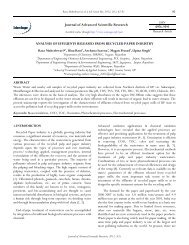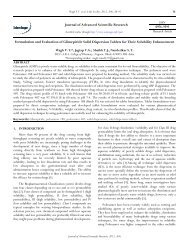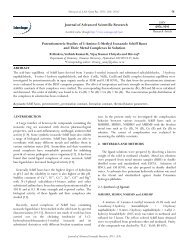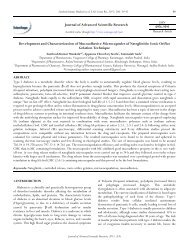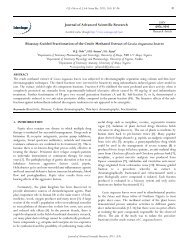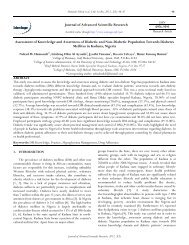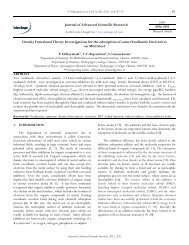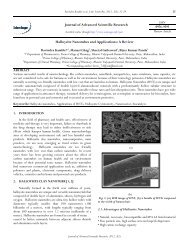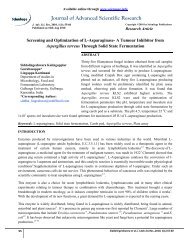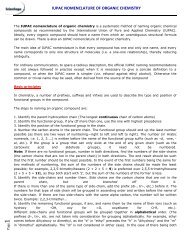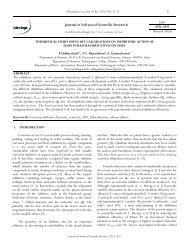Theoretical Evaluation of Corrosion Inhibition ... - Sciensage.info
Theoretical Evaluation of Corrosion Inhibition ... - Sciensage.info
Theoretical Evaluation of Corrosion Inhibition ... - Sciensage.info
Create successful ePaper yourself
Turn your PDF publications into a flip-book with our unique Google optimized e-Paper software.
P.Udhayakala et al, J Adv Scient Res, 2012, 3(2): 71-77 71<br />
Journal <strong>of</strong> Advanced Scientific Research<br />
Available online through http://www.sciensage.<strong>info</strong>/jasr<br />
ISSN<br />
0976-9595<br />
Research Article<br />
<strong>Theoretical</strong> <strong>Evaluation</strong> <strong>of</strong> <strong>Corrosion</strong> <strong>Inhibition</strong> Performance <strong>of</strong><br />
Some Triazole Derivatives<br />
P.Udhayakala a *, T.V. Rajendiran b , S. Gunasekaran c<br />
a Department <strong>of</strong> Chemistry, Dr.MGR Educational and Research Institute, Chennai -600095, India<br />
b<br />
Department <strong>of</strong> Chemistry, Pachaiyappa’s College, Chennai - 600 030, India<br />
C Department <strong>of</strong> Physics, Spectrophysics Research Laboratory, Pachaiyappa’s College, Chennai- 600 030, India<br />
*Corresponding author: udhayakala_kumar@yahoo.in<br />
ABSTRACT<br />
In this present paper, we have made an attempt to explain the adsorption mechanism and inhibition performance <strong>of</strong> two triazole<br />
derivatives, ie., 4-(benzylideneamino)-3-propyl-5-mercapto-1,2,4-triazole(BIPMT) and 4-(salicylidene amino)-3-propyl-5-<br />
mercapto-1,2,4-triazole (SIPMT), on mild steel using density functional theory (DFT) at the B3LYP/6-31G(d,p) level. Quantum<br />
chemical parameters such as E HOMO (highest occupied molecular orbital energy), E LUMO (lowest unoccupied molecular orbital<br />
energy), the energy gap(ΔE), hardness(η), S<strong>of</strong>tness(S), dipole moment(μ), electron affinity(EA), ionization potential(IE), the<br />
absolute electronegativity (χ) , the fraction <strong>of</strong> electron transferred (ΔN), electrophilicity index(ω) and the back-donation (ΔE Backdonation)<br />
have been calculated. The local reactivity has been studied through the Fukui and condensed s<strong>of</strong>tness indices in order to<br />
predict both the reactive centres and to know the possible sites <strong>of</strong> nucleophilic and electrophilic attacks. The obtained correlations<br />
and theoretical conclusions agree well with the experimental data.<br />
Keywords: Triazole, corrosion inhibitors, reactivity, DFT, Fukui function, s<strong>of</strong>tness indices, electrophilicity index.<br />
1. INTRODUCTION<br />
The study <strong>of</strong> corrosion processes and their inhibition by<br />
organic compounds is a very active field <strong>of</strong> research. Over the<br />
years, considerable efforts have been deployed to find suitable<br />
corrosion inhibitors <strong>of</strong> organic origin in various corrosive<br />
media [1–3]. It has been commonly recognized that organic<br />
inhibitor usually promotes formation <strong>of</strong> a chelate on the metal<br />
surface, which includes the transfer <strong>of</strong> electrons from the<br />
organic compounds to metal, forming coordinate covalent<br />
bond during such chemical adsorption process [4]. In this way,<br />
the metal acts as an electrophile, whereas the nucleophile<br />
centers <strong>of</strong> inhibitor molecule are normally hetero atoms with<br />
free electron pairs which are readily available for sharing, to<br />
form a bond. Among efficient corrosion inhibitors used to<br />
prevent the deterioration <strong>of</strong> mild steel are heterocyclic organic<br />
compounds consisting <strong>of</strong> nitrogen, sulphur and/or oxygen<br />
atoms [5-7]. The planarity and the lone electron pairs in the<br />
hetero atoms are important features that determine the<br />
adsorption <strong>of</strong> molecules on the metallic surface [8]. The<br />
inhibition efficiency has been closely related to the inhibitor<br />
adsorption abilities and the molecular properties for different<br />
kinds <strong>of</strong> organic compounds [9-11]. The power <strong>of</strong> the<br />
inhibition depends on the molecular structure <strong>of</strong> the inhibitor.<br />
Organic compounds, which can donate electrons to<br />
unoccupied d orbital <strong>of</strong> metal surface to form coordinate<br />
covalent bonds and can also accept free electrons from the<br />
metal surface by using their anti bonding orbital to form<br />
feedback bonds, constitute excellent corrosion inhibitors.<br />
Free electron pairs on hetero atoms or π electrons are<br />
readily available for sharing to form a bond and act as<br />
nucleophile centres <strong>of</strong> inhibitor molecules and greatly facilitate<br />
the adsorption process over the metal surface, whose atoms act<br />
as electrophiles [12]. Recently the effectiveness <strong>of</strong> an inhibitor<br />
molecule has been related to its spatial as well as electronic<br />
structure [13, 14]. Quantum chemical methods have already<br />
proven to be very useful in determining the molecular<br />
structure as well as elucidating the electronic structure and<br />
reactivity [15]. Density functional theory (DFT) [16, 17] has<br />
provided a very useful framework for developing new criteria<br />
for rationalizing, predicting, and eventually understanding<br />
many aspects <strong>of</strong> chemical processes [18-22]. A variety <strong>of</strong><br />
chemical concepts which are now widely used as descriptors <strong>of</strong><br />
chemical reactivity, e.g., electronegativity [19] hardness or<br />
s<strong>of</strong>tness quantities etc., appear naturally within DFT. The<br />
Fukui function [21] represents the relative local s<strong>of</strong>tness <strong>of</strong> the<br />
electron gas, measures the local electron density/population<br />
displacements corresponding to the inflow <strong>of</strong> a single electron.<br />
Journal <strong>of</strong> Advanced Scientific Research, 2012, 3(2)
2. COMPUTATIONAL DETAILS<br />
2.1. Quantum-chemical calculations methodology<br />
P.Udhayakala et al, J Adv Scient Res, 2012, 3(2): 71-77 72<br />
The reactive ability <strong>of</strong> the inhibitor is closely linked to their<br />
frontier molecular orbital (FMO), including highest occupied<br />
molecular orbital, HOMO, and lowest unoccupied molecular<br />
orbital, LUMO, and the other parameters such as hardness and<br />
s<strong>of</strong>tness. Quantum chemical studies have been successfully<br />
performed to link the corrosion inhibition efficiency with<br />
molecular orbital (MO) energy levels for some kinds <strong>of</strong> organic<br />
compounds [23, 24]. Although experimental work <strong>of</strong><br />
M.A.Quraishi et al. [25] provide valuable <strong>info</strong>rmation on the<br />
corrosion inhibition efficiency <strong>of</strong> 4-(benzylideneamino)-3-<br />
propyl-5-mercapto-1,2,4-triazole(BIPMT) and 4-<br />
(salicylideneamino)-<br />
3-propyl-5-mercapto-1,2,4-<br />
triazole(SIPMT), a deep understanding <strong>of</strong> the inhibition<br />
property remain unclear. To date, however, no study has been<br />
performed to investigate the corrosion inhibition efficiency <strong>of</strong><br />
SIPMT>BIPMT by using quantum chemical calculations. The<br />
objective <strong>of</strong> the present paper is to extend the study <strong>of</strong><br />
M.A.Quraishi et al. [25] by analyzing the inhibitive properties<br />
<strong>of</strong> SIPMT and BIPMT using DFT calculations. These properties<br />
are: the molecular structure, the dipole moment, E HOMO ,<br />
E LUMO , energy gap (ΔE), and those parameters that give<br />
valuable <strong>info</strong>rmation about the reactive behavior:<br />
electronegativity (χ), global hardness (η) and the fraction <strong>of</strong><br />
electrons transferred from the inhibitor molecule to the<br />
metallic atom (ΔN) and the back-donation(ΔE Back-donation ). The<br />
local reactivity has been analyzed by means <strong>of</strong> the Fukui<br />
indices, since they indicate the reactive regions, in the form <strong>of</strong><br />
the nucleophilic and electrophilic behavior <strong>of</strong> each atom in the<br />
molecule. Results obtained showed that the inhibition<br />
efficiency <strong>of</strong> SIPMT>BIPMT. It is well correlated with the<br />
experimental results. From the calculations we have explained<br />
which adsorption site is favoured to bind to the metal surface.<br />
4-(benzylideneamino)-3-propyl-5-mercapto-1,2,4-<br />
triazole(BIPMT)<br />
4-(salicylideneamino)-3-propyl-5-mercapto-1,2,4-<br />
triazole(SIPMT)<br />
Fig. 1: Names, molecular structure and the<br />
abbreviation <strong>of</strong> the inhibitors investigated<br />
BIPMT<br />
In computational chemistry tools, the DFT <strong>of</strong>fers the<br />
fundamentals for interpreting multiple chemical concepts used<br />
in different branches <strong>of</strong> Chemistry. In order to explore the<br />
theoretical-experimental consistency, quantum chemical<br />
calculations were performed with complete geometry<br />
optimizations using standard Gaussian-03 s<strong>of</strong>tware package<br />
[26]. Geometry optimization were carried out by B3LYP<br />
functional at the 6-31G (d,p) basis set and at the density<br />
functional theory (DFT) level. Recently, Density functional<br />
theory (DFT) has been used to analyze the characteristics <strong>of</strong> the<br />
inhibitor/ surface mechanism and to describe the structural<br />
nature <strong>of</strong> the inhibitor in the corrosion process [27, 28].<br />
Furthermore, DFT is considered a very useful technique to<br />
probe the inhibitor/surface interaction as well as to analyze the<br />
experimental data. The results <strong>of</strong> the geometry optimization <strong>of</strong><br />
the compounds BIPMT and SIPMT are presented in Figure 2.<br />
SIPMT<br />
Figure 2. Optimized molecular structure <strong>of</strong> BIPMT and<br />
SIPMT by B3LYP/6-31G (d,p)<br />
3. RESULTS AND DISCUSSION<br />
Density functional theory (DFT) [16] has been quite<br />
successful in providing theoretical basis for popular qualitative<br />
chemical concepts like electronegativity (χ), hardness (η),<br />
s<strong>of</strong>tness(S) and local ones such as Fukui function, F(r) and local<br />
Journal <strong>of</strong> Advanced Scientific Research, 2012, 3(2)
s<strong>of</strong>tness, s(r). According to Koopman’s theorem [29] the<br />
ionization potential (IE) and electron affinity (EA) <strong>of</strong> the<br />
inhibitors are calculated using the following equations and<br />
hence χ and η are calculated.<br />
IE = -E HOMO<br />
EA = -E LUMO<br />
The higher HOMO energy corresponds to the more<br />
reactive molecule in the reactions with electrophiles, while<br />
lower LUMO energy is essential for molecular reactions with<br />
nucleophiles [30].<br />
IE EA<br />
<br />
2<br />
IE EA<br />
<br />
2<br />
The global s<strong>of</strong>tness(S) is the inverse <strong>of</strong> the global hardness [31].<br />
1<br />
S <br />
<br />
Electronegativity, hardness and s<strong>of</strong>tness have proved to be<br />
very useful quantities in the chemical reactivity theory. The<br />
electronegativity <strong>of</strong> the inhibitor molecules is lower than the<br />
bulk iron. Hence, electron move from the molecules with<br />
lower electronegativity (inhibitor compound) toward that <strong>of</strong> a<br />
higher value (metal surface) until the equilibrium in chemical<br />
potential is reached.<br />
The global electrophilicity index (ω), introduced by Parr<br />
[32], calculated using the electronic chemical potential and<br />
chemical hardness is given by<br />
ω = μ 2 /2η<br />
According to the definition, this index measures the<br />
propensity <strong>of</strong> chemical species to accept electrons [33]. A<br />
good, more reactive, nucleophile is characterized by lower<br />
value <strong>of</strong> ω; and conversely a good electrophile is characterized<br />
by a high value <strong>of</strong> ω. This new reactivity index measures the<br />
stabilization in energy when the system acquires an additional<br />
electronic charge ΔN from the environment.<br />
According to Pearson theory [31] the fraction <strong>of</strong> transferred<br />
electrons (ΔN) from the inhibitor molecule to the metallic<br />
atom can be calculated. For a reaction <strong>of</strong> two systems with<br />
different electronegativities (as a metallic surface and an<br />
inhibitor molecule) the following mechanism will take place:<br />
the electronic flow will occur from the molecule with the<br />
lower electronegativity toward that <strong>of</strong> higher value, until the<br />
chemical potentials are the same. For the calculation the<br />
following formula was used [34].<br />
Fe<br />
inh<br />
N<br />
<br />
2(<br />
<br />
<br />
<br />
Fe<br />
inh <br />
Where χ Fe and χ inh denote the absolute electronegativity <strong>of</strong><br />
iron and inhibitor molecule respectively η Fe and η inh denote the<br />
absolute hardness <strong>of</strong> iron and the inhibitor molecule<br />
P.Udhayakala et al, J Adv Scient Res, 2012, 3(2): 71-77 73<br />
respectively. In order to calculate the fraction <strong>of</strong> electrons<br />
transferred, the theoretical value for the electronegativity <strong>of</strong><br />
bulk iron was used χ Fe =7.0 eV [34] and a global hardness <strong>of</strong> η Fe<br />
= 0 by assuming that for a metallic bulk I= A [35]. The<br />
difference in electronegativity drives the electron transfer, and<br />
the sum <strong>of</strong> the hardness parameters acts as a resistance [31].<br />
The local selectivity <strong>of</strong> a corrosion inhibitor is best analyzed by<br />
means <strong>of</strong> condensed Fukui function. The change in electron<br />
density is the nucleophilic f + (r) and electrophilic f - (r) Fukui<br />
functions, which can be calculated using the finite difference<br />
approximation as follows [36].<br />
f k+ = q N+1 - q N<br />
f k<br />
-<br />
= q N - q N-1<br />
Where, q N, q N+1 and q N-1 are the electronic population <strong>of</strong><br />
the atom k in neutral, anionic and cationic systems.<br />
Condensed s<strong>of</strong>tness indices allowing the comparison <strong>of</strong><br />
reactivity between similar atoms <strong>of</strong> different molecules can be<br />
calculated easily starting from the relation between the Fukui<br />
function f (r) and the local s<strong>of</strong>tness s(r) [37].<br />
()<br />
r N<br />
<br />
s( r) f ( r)<br />
S<br />
N<br />
<br />
<br />
vr ( ) vr ( )<br />
From this relation, one can infer that local s<strong>of</strong>tness and<br />
Fukui function are closely related, and they should play an<br />
important role in the field <strong>of</strong> chemical reactivity.<br />
According to the simple charge transfer model for donation<br />
and back-donation <strong>of</strong> charges proposed recently by Gomez et<br />
al., [38] an electronic back-donation process might be<br />
occurring governing the interaction between the inhibitor<br />
molecule and the metal surface. The concept establishes that if<br />
both processes occur, namely charge transfer to the molecule<br />
and back-donation from the molecule, the energy change is<br />
directly proportional to the hardness <strong>of</strong> the molecule, as<br />
indicated in the following expression.<br />
<br />
ΔE Back-donation<br />
<br />
4<br />
The ΔE Back-donation implies that when η > 0 and ΔE Backdonation<br />
< 0 the charge transfer to a molecule, followed by a<br />
back-donation from the molecule, is energetically favored. In<br />
this context, hence, it is possible to compare the stabilization<br />
among inhibiting molecules, since there will be an interaction<br />
with the same metal, then, it is expected that it will decrease as<br />
the hardness increases.<br />
3.1. <strong>Theoretical</strong> assessment<br />
The inhibition effect <strong>of</strong> inhibitor compound is usually<br />
ascribed to adsorption <strong>of</strong> the molecule on metal surface. There<br />
can be physical adsorption (physisorption) and chemical<br />
adsorption (chemisorption) depending on the adsorption<br />
strength. When chemisorption takes place, one <strong>of</strong> the reacting<br />
Journal <strong>of</strong> Advanced Scientific Research, 2012, 3(2)
species acts as an electron pair donor and the other one acts as<br />
an electron pair acceptor. The energy <strong>of</strong> the highest occupied<br />
molecular orbital (E HOMO ) measures the tendency towards the<br />
donation <strong>of</strong> electron by a molecule [39]. High values <strong>of</strong> E HOMO<br />
have a tendency <strong>of</strong> the molecule to donate electrons to<br />
appropriate acceptor molecules with low energy, empty<br />
molecular orbital. Increasing values <strong>of</strong> E HOMO facilitate<br />
adsorption and therefore enhance the inhibition efficiency, by<br />
influencing the transport process through the adsorbed layer.<br />
Therefore, higher values <strong>of</strong> E HOMO indicate better tendency<br />
towards the donation <strong>of</strong> electron, enhancing the adsorption <strong>of</strong><br />
the inhibitor on mild steel and therefore better inhibition<br />
efficiency. E LUMO indicates the ability <strong>of</strong> the molecule to accept<br />
electrons. The binding ability <strong>of</strong> the inhibitor to the metal<br />
surface increases with increasing <strong>of</strong> the HOMO and decreasing<br />
<strong>of</strong> the LUMO energy values. The frontier molecular orbital<br />
diagrams <strong>of</strong> BIPMT and SIPMT is represented in figure 3.<br />
Table 1 represents the total energy and calculated energy levels<br />
in (eV) <strong>of</strong> the HOMO, LUMO and energy gap <strong>of</strong> the<br />
investigated molecules.<br />
P.Udhayakala et al, J Adv Scient Res, 2012, 3(2): 71-77 74<br />
only <strong>of</strong>fer electrons to unoccupied orbital <strong>of</strong> the metal but also<br />
accept free electrons from the metal [43]. A molecule with a<br />
low energy gap is more polarizable and is generally associated<br />
with the high chemical activity and low kinetic stability and is<br />
termed s<strong>of</strong>t molecule [44]. S<strong>of</strong>t molecule is more reactive than<br />
a hard molecule because a hard molecule has a large energy<br />
gap. The results as indicated in table 1 shows that inhibitor<br />
SIPMT has the lowest energy gap, this means that the molecule<br />
could have better performance as corrosion inhibitor.<br />
Table 2. Quantum chemical descriptors for inhibitor BIPMT and<br />
SIPMT calculated using B3LYP/6-31G (d,p).<br />
Parameters BIPMT SIPMT<br />
Ionization potential (IE) /(eV)<br />
Electron affinity (EA) /(eV)<br />
Chemical Potential (μ ) /eV<br />
Global Hardness(η) / eV<br />
Electronegativity( χ) (eV)<br />
Global s<strong>of</strong>tness(S)<br />
Electrophilicity ( ω)<br />
6.089229<br />
2.034913<br />
-4.062071<br />
2.027158<br />
4.062071<br />
0.493301<br />
4.069841<br />
5.916977<br />
1.998449<br />
-3.957713<br />
1.959264<br />
3.957713<br />
0.510396<br />
3.997289<br />
Table 1. Global chemical reactivity indices for BIPMT and<br />
SIPMT calculated using B3LYP/6-31G (d,p).<br />
Parameters BIPMT SIPMT<br />
E (au)<br />
E HOMO (eV)<br />
E LUMO (eV)<br />
Energy gap(ΔE) (eV)<br />
-1082.86706<br />
-6.089229<br />
-2.034913<br />
4.054316<br />
- 1158.08684<br />
-5.916977<br />
-1.998449<br />
3.918528<br />
According to the frontier molecular orbital theory (FMO) <strong>of</strong><br />
chemical reactivity, transition <strong>of</strong> electron is due to interaction<br />
between highest occupied molecular orbital (HOMO) and<br />
lowest unoccupied molecular orbital (LUMO) <strong>of</strong> reacting<br />
species [40]. E HOMO is a quantum chemical parameter which is<br />
<strong>of</strong>ten associated with the electron donating ability <strong>of</strong> the<br />
molecule. High value <strong>of</strong> E HOMO is likely to a tendency <strong>of</strong> the<br />
molecule to donate electrons to appropriate acceptor molecule<br />
<strong>of</strong> low empty molecular orbital energy [41]. The inhibitor does<br />
not only donate electron to the unoccupied d orbital <strong>of</strong> the<br />
metal ion but can also accept electron from the d-orbital <strong>of</strong> the<br />
metal leading to the formation <strong>of</strong> a feed back bond. According<br />
to our result, the highest E HOMO value -5.916977 (eV) <strong>of</strong><br />
SIPMT indicates the better inhibition efficiency.<br />
The energy gap, (ΔE = E LUMO – E HOMO ) is an important<br />
parameter as a function <strong>of</strong> reactivity <strong>of</strong> the inhibitor molecule<br />
towards the adsorption on the metallic surface. As ΔE<br />
decreases, the reactivity <strong>of</strong> the molecule increases leading to<br />
increase in the %IE <strong>of</strong> the molecule. Lower values <strong>of</strong> the<br />
energy difference will render good inhibition efficiency,<br />
because the energy to remove an electron from the last<br />
occupied orbital will be low [42]. Reportedly, excellent<br />
corrosion inhibitors are usually organic compounds which not<br />
Ionization energy is a fundamental descriptor <strong>of</strong> the<br />
chemical reactivity <strong>of</strong> atoms and molecules. High ionization<br />
energy indicates high stability and chemical inertness and small<br />
ionization energy indicates high reactivity <strong>of</strong> the atoms and<br />
molecules [45]. The low ionization energy 5.916977 (eV) <strong>of</strong><br />
SIPMT indicates the high inhibition efficiency.<br />
Absolute hardness and s<strong>of</strong>tness are important properties to<br />
measure the molecular stability and reactivity. It is apparent<br />
that the chemical hardness fundamentally signifies the<br />
resistance towards the deformation or polarization <strong>of</strong> the<br />
electron cloud <strong>of</strong> the atoms, ions or molecules under small<br />
perturbation <strong>of</strong> chemical reaction. A hard molecule has a large<br />
energy gap and a s<strong>of</strong>t molecule has a small energy gap[46]. In<br />
our present study SIPMT with low hardness value 1.959264<br />
(eV) compared with BIPMT, have a low energy gap.<br />
Normally, the inhibitor with the least value <strong>of</strong> global hardness<br />
(hence the highest value <strong>of</strong> global s<strong>of</strong>tness) is expected to have<br />
the highest inhibition efficiency [12]. For the simplest transfer<br />
<strong>of</strong> electron, adsorption could occur at the part <strong>of</strong> the molecule<br />
where s<strong>of</strong>tness(S), which is a local property, has a highest value<br />
[47]. SIPMT with the s<strong>of</strong>tness value <strong>of</strong> 0.510396 has the<br />
highest inhibition efficiency.<br />
According to Sanderson’s electronegativity equalization<br />
principle [48], BIPMT with a high electronegativity quickly<br />
reaches equalization and hence low reactivity is expected which<br />
in turn indicates low inhibition efficiency. The table 2 shows<br />
the order <strong>of</strong> electronegativity as BIPMT>SIPMT. Hence an<br />
increase in the difference <strong>of</strong> electronegativity between the<br />
metal and the inhibitor is observed in the order<br />
SIPMT>BIPMT. The electrophilicity index, ω, shows the<br />
ability <strong>of</strong> the inhibitor molecules to accept electrons. It is a<br />
Journal <strong>of</strong> Advanced Scientific Research, 2012, 3(2)
measure <strong>of</strong> the stabilization in energy after a system accepts<br />
additional amount <strong>of</strong> electron charge from the environment<br />
[49]. In our present study, SIPMT is the strongest nucleophile<br />
while BIPMT is the strongest electrophile.<br />
The number <strong>of</strong> electrons transferred (ΔN) was also<br />
calculated and tabulated in Table 3. Values <strong>of</strong> ΔN show that the<br />
inhibition efficiency resulting from electron donation agrees<br />
with Lukovits’s study [33]. If ΔN < 3.6, the inhibition<br />
efficiency increases by increasing electron-donating ability <strong>of</strong><br />
these inhibitors to donate electrons to the metal surface and it<br />
increases in the following order: SIPMT>BIPMT. The results<br />
indicate that ΔN values correlates strongly with experimental<br />
inhibition efficiencies. Thus, the highest fraction <strong>of</strong> electrons<br />
transferred is associated with the best inhibitor (SIPMT), while<br />
the least fraction is associated with the inhibitor that has the<br />
least inhibition efficiency (BIPMT).<br />
P.Udhayakala et al, J Adv Scient Res, 2012, 3(2): 71-77 75<br />
-<br />
respect to nucleophilic attack. On the other hand, f k<br />
corresponds to reactivity with respect to electrophilic attack or<br />
when the molecule loss electrons. For nucleophilic attack the<br />
most reactive site <strong>of</strong> BIPMT and SIPMT is on the C (1). It is<br />
clear that C (1) atom <strong>of</strong> BIPMT and SIPMT has more<br />
nucleophilic character and is involved in the chemical reactivity<br />
<strong>of</strong> the molecules with metal surface which exhibit the<br />
adsorption mechanism. The Fukui function f k-<br />
is confirmed by<br />
the electrophilic attack at the site S(9) atom in both the<br />
compounds.<br />
In Table 3, the calculated ΔE back-donation values for both,<br />
inhibitors are listed. The order followed is: SIPMT > BIPMT,<br />
which indicates that back-donation is favoured for the SIPMT,<br />
which is the best inhibitor.<br />
Table 3. The number <strong>of</strong> electron transferred (ΔN) and ΔE back<br />
donation (eV) calculated for inhibitor BIPMT and SIPMT.<br />
Parameters BIPMT SIPMT<br />
Transferred electrons fraction (ΔN)<br />
ΔE back-donation / (eV)<br />
0.724514<br />
-0.5068795<br />
0.776385<br />
-0.489816<br />
The use <strong>of</strong> Mulliken population analysis to estimate the<br />
adsorption centres <strong>of</strong> inhibitors has been widely reported and it<br />
is mostly used for the calculation <strong>of</strong> the charge distribution<br />
over the whole skeleton <strong>of</strong> the molecule [50]. There is a<br />
general consensus by several authors that the more negatively<br />
charged an heteroatom, is the more it can be adsorbed on the<br />
metal surface through the donor-acceptor type reaction [43].<br />
It is important to consider the situation corresponding to a<br />
molecule that is going to receive a certain amount <strong>of</strong> charge at<br />
some centre and is going to back donate a certain amount <strong>of</strong><br />
charge through the same centre or another one [38 ]. Parr and<br />
Yang proposed that larger value <strong>of</strong> Fukui function indicate<br />
more reactivity [17]. Hence greater the value <strong>of</strong> condensed<br />
Fukui function, the more reactive is the particular atomic<br />
centre in the molecule.<br />
The local reactivity <strong>of</strong> molecule BIPMT and SIPMT is analyzed<br />
by means <strong>of</strong> the condensed Fukui function. The condensed<br />
Fukui function and local s<strong>of</strong>tness indices allow one distinguish<br />
each part <strong>of</strong> the molecule on the basis <strong>of</strong> its distinct chemical<br />
behaviour [51] due to the different substituted functional<br />
group. The f k+<br />
measures the changes <strong>of</strong> density when the<br />
molecules gains electrons and it corresponds to reactivity with<br />
HOMO <strong>of</strong> BIPMT<br />
LUMO <strong>of</strong> BIPMT<br />
HOMO <strong>of</strong> SIPMT<br />
LUMO <strong>of</strong> SIPMT<br />
Figure 3. Frontier molecular orbital diagrams <strong>of</strong> BIPMT and<br />
SIPMT by B3LYP/6-31G (d,p)<br />
Journal <strong>of</strong> Advanced Scientific Research, 2012, 3(2)
Table 4. Fukui and local s<strong>of</strong>tness indices for nucleophilic and<br />
electrophilic attacks in BIPMT atoms calculated from Mulliken<br />
atomic charges<br />
P.Udhayakala et al, J Adv Scient Res, 2012, 3(2): 71-77 76<br />
Table 5. Fukui and local s<strong>of</strong>tness indices for nucleophilic and<br />
electrophilic attacks in SIPMT atoms calculated from Mulliken<br />
atomic charges.<br />
Atom No f + k f - k<br />
+<br />
s k<br />
-<br />
s k<br />
1 C 0.118727 0.009049 0.058557 0.004463<br />
2 H 0.062009 0.028921 0.030583 0.014264<br />
3 N 0.117778 -0.01167 0.058089 -0.005756<br />
4 N -0.04978 0.015923 -0.024552 0.007853<br />
5 C 0.02179 0.056635 0.010747 0.027933<br />
6 C 0.035723 -0.001869 0.017619 -0.000922<br />
7 N 0.052461 0.115437 0.025874 0.056935<br />
8 N 0.039193 0.1183 0.019330 0.058347<br />
9 S 0.055277 0.274722 0.027263 0.135497<br />
10 H 0.037219 0.0569 0.018356 0.028064<br />
11 C -0.004511 -0.025692 -0.002225 -0.012672<br />
12 H -0.021041 0.036609 -0.010378 0.018056<br />
13 H 0.051108 0.050266 0.025207 0.024792<br />
14 C -0.016202 -0.014967 -0.007991 -0.007382<br />
15 H 0.065624 0.017963 0.032366 0.008859<br />
16 H -0.005948 0.061947 -0.002933 0.030553<br />
17 C -0.005946 -0.013655 -0.002932 -0.006735<br />
18 H -0.022072 0.006764 -0.010886 0.003336<br />
19 H 0.039413 0.044528 0.019439 0.021962<br />
20 H 0.001421 -0.00276 0.000701 -0.001361<br />
21 C -0.022479 -0.009929 -0.011087 -0.004897<br />
22 C 0.018233 0.014955 0.008993 0.007376<br />
23 C 0.043185 0.010337 0.021299 0.005098<br />
24 C 0.004773 0.003275 0.002354 0.001615<br />
25 C -0.001908 0.005097 -0.000941 0.002514<br />
26 H 0.058831 0.007162 0.029016 0.003532<br />
27 C 0.047661 0.015028 0.023507 0.007412<br />
28 H 0.070945 0.03541 0.034991 0.017465<br />
29 H 0.071419 0.032424 0.035225 0.015992<br />
30 H 0.078861 0.039192 0.038895 0.01933<br />
31 H 0.05824 0.023696 0.028725 0.011687<br />
4. CONCLUSION<br />
Quantum chemical parameters such as E HOMO , E LUMO ,<br />
energy gap(ΔE), hardness(η), S<strong>of</strong>tness(S), electron<br />
affinity(EA), ionization potential(IE), the absolute<br />
electronegativity (χ), the fraction <strong>of</strong> electron transferred (ΔN),<br />
electrophilicity index(ω) and the back-donation (ΔE Back-donation )<br />
were calculated using density functional theory at B3LYP/6-<br />
31-G(d,p) basis set. The inhibition efficiency <strong>of</strong> the molecules<br />
BIPMT and SIPMT obtained quantum chemically increase with<br />
the increase in E HOMO , and decrease in energy gap (ΔE). SIPMT<br />
has the highest inhibition efficiency because it had the highest<br />
HOMO energy and ΔN values and lowest energy gap it was<br />
most capable <strong>of</strong> <strong>of</strong>fering electrons and it could have a better<br />
performance as corrosion inhibitor. Fukui function shows the<br />
nucleophilic and electrophilic attacking sites in the investigated<br />
inhibitors. Comparison <strong>of</strong> theoretical and experimental data<br />
exhibit good correlation confirming the reliability <strong>of</strong> the<br />
method employed here.<br />
Atom No f + k f - k<br />
+<br />
s k<br />
-<br />
s k<br />
1 C 0.161197 0.012297 0.082274 0.006276<br />
2 H 0.065617 0.017827 0.033491 0.009098<br />
3 N 0.105634 -0.016117 0.053915 -0.008226<br />
4 N -0.046667 0.026711 -0.023818 0.013633<br />
5 C 0.034453 0.048395 0.017585 0.024701<br />
6 C 0.010977 0.005207 0.005603 0.002658<br />
7 N 0.03512 0.118078 0.017926 0.060266<br />
8 N 0.043947 0.108734 0.022430 0.055497<br />
9 S 0.057385 0.272314 0.029289 0.138988<br />
10 H 0.04293 0.053841 0.021911 0.027480<br />
11 C -0.011948 -0.02258 -0.006098 -0.011525<br />
12 H -0.023978 0.039101 -0.012238 0.019957<br />
13 H 0.036143 0.051589 0.018447 0.026331<br />
14 C -0.004167 -0.021977 -0.002126 -0.011217<br />
15 H 0.030368 0.049682 0.015499 0.025357<br />
16 H 0.039434 0.021451 0.020127 0.010948<br />
17 C -0.01647 -0.007768 -0.008406 -0.003965<br />
18 H -0.029911 -0.010077 -0.015266 -0.005143<br />
19 H 0.045429 0.042286 0.023187 0.021583<br />
20 H 0.007927 0.015026 0.004046 0.007669<br />
21 C -0.0574 -0.010044 -0.029297 -0.005126<br />
22 C 0.037102 0.02445 0.018937 0.012479<br />
23 C 0.065133 0.01065 0.033244 0.005436<br />
24 C 0.017506 0.007982 0.008935 0.004074<br />
25 C -0.004658 0.006346 -0.002377 0.003239<br />
26 H 0.044703 0.006912 0.022816 0.003528<br />
27 C 0.049891 0.012593 0.025464 0.006427<br />
28 H 0.072417 0.035696 0.036961 0.018219<br />
29 H 0.061614 0.033394 0.031447 0.017044<br />
30 H 0.077454 0.039345 0.039532 0.020081<br />
31 O 0.017882 0.009004 0.009127 0.002101<br />
32 H 0.034935 0.019651 0.017831 0.004586<br />
5. REFERENCES<br />
1. Bouklah M, Hammouti B, Benhadda T, Benkadour M. J Appl<br />
Electrochem, 2005; 35(11): 1095.<br />
2. Fiala A, Chibani A, Darchen A, Boulkamh A, Djebbar K, Appl<br />
Surf Sci, 2007; 253(24): 9347.<br />
3. Fouda AS, Al-Sarawy AA, El- Katori EE. Desalination, 2006;<br />
201: 1.<br />
4. Ajmal M, Mideen AS, Quaraishi MA. Corros Sci, 1994; 36: 79.<br />
5. Bastidas JM, Polo JL, Cano L, J Appl Electrochem, 2000; 30:<br />
1173.<br />
6. Obot IB, Obi-Egbedi NO, Surface Review and Letters, 2008;<br />
15(6): 903.<br />
7. Chebabem D, Ait Chikh Z, Hajjaji N, Srhiri A, and Zucchi F,<br />
Corros Sci, 1993 ; 49 : 309.<br />
8. Abd El-Rehim SS, Ibrahim MAM and Khaled FF. J Appl<br />
Electrochem, 1999; 29: 593.<br />
9. Wang HL, Liu RB and Xin J. Corros Sci, 2004; 46: 2455.<br />
10. Rengamati S, Muralidharan S , Anbu Kulamdainathan M,<br />
Venkatakrishna Iyer S. J Appl Electrochem, 1994; 24: 355.<br />
11. Ebenso EE. Bull Electrochem, 2003; 19: 209.<br />
Journal <strong>of</strong> Advanced Scientific Research, 2012, 3(2)
12. Ebenso EE, David A. Isabirye and Nnabuk O.Eddy. Int J Mol Sci,<br />
2010; 11: 2473.<br />
13. Stoyanova AE and Peyerimh<strong>of</strong>f SD. Electro Chim Acta, 2002; 47:<br />
1365.<br />
14. Valdez LMR, Villafane AM and Maitnik DG. J.Mol.Struct<br />
(THEOCHEM), 2005; 716: 61.<br />
15. Kraka E, Cremer D. J Am Chem Soc, 2000; 122: 8245.<br />
16. Hohenberg P and Kohn W. Phys Rev, 1964; B136: 864.<br />
17. Parr RG and Yang W. Density Functional Theory <strong>of</strong> Atoms and<br />
Molecules; (Oxford University Press: New York, 1989).<br />
18. Cohen MH. In Topics in Current Chemistry; Nalewajski RF,<br />
Ed.; (Springer-Verlag: Heidelberg, Germany, 1996; 183: p 143.<br />
19. Sanderson RT. J Am Chem Soc, 1952; 74272.<br />
20. Awad MK. J Electroanal Chem, 2004; 567: 219.<br />
21. Parr RG and Yang W. J Am Chem Soc,1984;106: 4049.<br />
22. Pearson RG. J Am Chem Soc, 1963; 85: 3533.<br />
23. Fang J and Li J. J Mol Struct (Theochem), 2002; 593: 179.<br />
24. Arslan T, Kandemirli F, Ebenso EE, Love I and Alemu H. Corros<br />
Sci, 2009; 51: 35.<br />
25. Quraishi MA and Sharma HK. Ind J Chem Tech, 2005; 12: 98.<br />
26. Frisch MJ, Trucks GW, Schlegel HB et al. Gaussian 03,<br />
Gaussian, Inc.: Pittsburgh PA, 2003.<br />
27. Rodriguez-Valdez L, Martinez-Villafane A and Glossman-<br />
Mitnik D. J Mol Struct, (THEOCHEM), 2005; 716: 61.<br />
28. Lashkari M and Arshadi MR. Chem Phys, 2004; 299: 131.<br />
29. Koopmans T. Physica, 1933; 1: 104.<br />
30. Rauk A. Orbital interaction Theory <strong>of</strong> Organic Chemistry, 2 nd<br />
Edn (John Wiley & Sons: Newyork, 2001) p. 34.<br />
31. Pearson RG. Inorg Chem, 1988; 27: 734.<br />
32. Parr RG, Szentpaly L and Liu S. J Am Chem. Soc, 1999; 121:<br />
1922.<br />
33. Lukovits I, Kalman E, and Zucchi F. <strong>Corrosion</strong>, 2001; 57: 3.<br />
P.Udhayakala et al, J Adv Scient Res, 2012, 3(2): 71-77 77<br />
34. Sastri VS and Perumareddi JR. Corros Sci, 1997; 53: 617.<br />
35. Dewar MJS and Thie W. J Am Chem Soc, 1977; 99: 4899.<br />
36. Lee C, Yang W and Parr RG. J Mol Struct (THEOCHEM), 1988;<br />
163: 305.<br />
37. Wang H,Wang X, Wang H, Wang L and Liu A. J Mol Model,<br />
2007; 13: 147.<br />
38. Gomez B, Likhanova NV, Dominguez-Aguilar MA, Martinez-<br />
Palou R Vela A and Gasquez J, J Phy Chem, 2006 ; B 110:<br />
8928.<br />
39. El Ashry HE, El Nemr A, Esawy SA and Ragab S. Electrochim<br />
Acta, 2006; 51: 3957.<br />
40. Musa AY, Kadhum AH, Mohamad AB, Rohoma AB and<br />
Mesmari H. J Mol Struct. 2010; 969: 233.<br />
41. Gece G and Bilgic S. Corros Sci, 2009; 51: 1876.<br />
42. Obot IB, Obi-Egbedi NO and Umoren SA. Int J Electchem Sci,<br />
2009; 4: 863.<br />
43. Breket G Hur E and Ogretir C. J Mol Stru (THEO CHEM) 2002;<br />
578:79.<br />
44. Fleming I. Frontier Orbitals and Organic Chemical Reactions,<br />
(John Wiley and Sons, NewYork, 1976).<br />
45. Chakraborty T and Ghosh DC. Mol Phys, 2010; 108(16): 2081.<br />
46. Obi-Egbedi NO, Obot IB, El-Khaiary MI, Umoren SA and<br />
Ebenso EE. Int J Electro Chem Sci, 2011; 6: 5649.<br />
47. Hasanov R, Sadikglu M, and Bilgic S. Appl Surf Sci, 2007; 253:<br />
3913.<br />
48. Geerlings P and De Pr<strong>of</strong>t F. Int J Mol Sci, 2002; 3: 276.<br />
49. Liu S. J Chem Sci, 2005; 117: 477.<br />
50. Sahin M, Gece G, Karci E and Bilgic S. J Appl Electrochem, 2008;<br />
38: 809.<br />
51. Fukui K, Yonezewa T and Shingu H. J Chem Phys, 1952; 20:<br />
722.<br />
Journal <strong>of</strong> Advanced Scientific Research, 2012, 3(2)



